
Rainbow Swastika: Pink Panzers and Swishy Soldaten
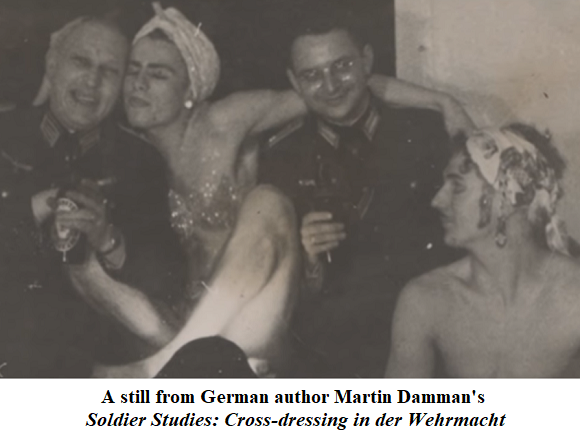
The attempt by Mark Dreyfus and Labor to smear Peter Dutton over the univited neo-Nazi presence at the Women’s Rights protest in Melbourne has the potential to backfire spectacularly, not the least because the question of Nazism and the LGBTIQ movement has long been an extremely controversial issue.
Indeed, it was a live topic from the early days of the Nazi Party, as its enemies sought to gather intelligence on Hitler and other leaders. According to Ludwig Lenz, a contemporary researcher at the Sex Research Institute in Berlin known for performing some of the first sex reassignment surgeries: “not ten percent of the men who, in 1933, took the fate of Germany into their hands, were sexually normal.” The Institute was itself destroyed by Hitler’s paramilitary SA Brown Shirts in 1933, apparently because of its massive documentary collection. This included records of court-referred Nazi sex offenders, rapists, child molesters and pederasts, along with some 40,000 intimate interviews with members of the Nazi Party about their sexuality. It seems this material may have exposed the wide range sexual proclivities enjoyed by the Nazi leadership.
The issue had become intensely political as the conflict in Germany between the Nazis and the far-left grew in intensity in the 1920s and 1930s. Both the Social Democratic Party of Germany (SPD) and Communist Party of Germany (KPD) resorted to homophobic slurs to discredit their opponents. In particular, they exploited the infamous ‘Eulenburg Affair’, described as “the biggest homosexual scandal ever”. (Gert Hekma, “Sodomy, Effeminacy, Identity: Mobilizations for Same-Sexual Loves and Practices before the Second World War”, in The Ashgate Research Companion to Lesbian and Gay Activism, 2015). This involved a high-profile series of courts-martial and criminal and libel trials regarding accusations of homosexual conduct among prominent members of Kaiser Wilhelm II’s cabinet and entourage during 1907–1909. These had been prompted by accusations 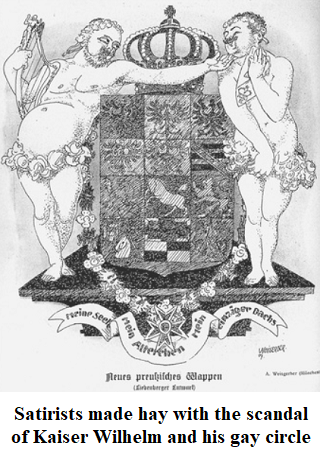 by the socialist journalist Maximilian Harden about a homosexual affair between the Kaiser Wilhelm II’s close friend Philipp, Prince of Eulenburg, and Lieutenant General Kuno, Graf von Moltke, adjutant to the Kaiser and the military commander of Berlin. As the scandal developed, the homophobic slur, ‘Liebenberg Round Table’ came to be widely used for the homosexual circle around the Kaiser.
by the socialist journalist Maximilian Harden about a homosexual affair between the Kaiser Wilhelm II’s close friend Philipp, Prince of Eulenburg, and Lieutenant General Kuno, Graf von Moltke, adjutant to the Kaiser and the military commander of Berlin. As the scandal developed, the homophobic slur, ‘Liebenberg Round Table’ came to be widely used for the homosexual circle around the Kaiser.
As one historian has noted, “while far from German Social Democracy’s finest hour morally [this] was a shrewd tactic politically” as it exploited popular homophobia. (Christopher Dillon, “Masculinity, Political Culture, and the Rise of Nazism”, in The Palgrave Handbook of Masculinity and Political Culture in Europe, 2018). Confronted with the rise of Nazism, the Communists and the SPD encouraged the perception that homosexuality was closely linked to militarism and would lead to war. They pointed not only to the Eulenburg affair but also to the homosexuality of a number of prominent Nazis, especially Ernst Röhm, the head of the SA. In street conflict , Communist militants taunted the SA with shouts of ‘Hot Röhm!’ and ‘SA, Trousers Down!’, building up a hatred and thirst for revenge amongst the Nazis that would soon be sated.
Later, after the SPD and KPD had been brutally suppressed, and WWII broke out, the matter inevitably concerned allied historians, political scientists, and psychologists. An early major work was Germany’s National Vice (1945), a study of homosexuality under the Nazis carried out by Samuel Igra, and similar scholarship continued up until the onset of political correctness in the 1970s, when a veil was drawn across the topic by an increasingly powerful LGBTIQ lobby. Igra’s book later inspired The Pink Swastika: Homosexuality in the Nazi Party (1995), a controversial study by Scott Lively and Kevin Abrams.
Ironically, one of the last references to the topic from the Left was provided by the lesbian feminist Kate Millett in hetr Sexual Politics (1971), the radical manifesto of second-wave feminism. There she commented on the homosexual male-supremacist character of the Nazi State”:
The virility cult of Nazi male culture, its emphasis upon ‘leaders’ and male community, lent the entire Nazi era a curious tone of repressed homosexuality, neurotically anti-social and sadistic in character.
Millett felt that neither feminists nor lesbians would be tolerated in such a male supremacist regime.
The relationship of Hitler and Röhm has always been a concern of historians, especially given Röhm’s grim fate. While his orientation has always been known, that of the Führer remains a mystery. Indeed, a massive war-time research project undertaken by the American Office of Strategic Services reported in 1943 that the Führer enjoyed a range of perversions. Although mountains of lurid material were subsequently unearthed by historians, much of it is regarded as unreliable and no consensus has been reached, except that Hitler suffered from paranoia, self-loathing, and didn’t enjoy conventional heterosexual relationships. He may have simply been ‘asexual’, or a repressed passive homosexual who went (or tried to go) through the motions of heterosexuality. He may also have been a male prostitute in Vienna as he struggled to make a living as a talentless artist; certainly he had more money than he could ever have earned selling mediocre watercolours. He was also a denizen of the overnight shelters and men’s hostels that were described as “hotbeds of male prostitution” by the father of the Gay Rights movement, Magnus Hirschfeld.
According to some scholars (e.g., The Hidden Hitler by Lothar Machtan (2001)), Hitler was undoubtedly gay, while others (e.g., The Psychopathic God: Adolf Hitler, by Robert G. L. Waite (1993)) believe he was addicted to extreme forms of what used to be regarded (prior to the progressive liberalisation of sexual morality in Western societies) as sexual perversion. Such activities included sadomasochism, self-flagellation, and especially coprophilia, the regular practice of which may have been the reason for the apparent suicide of one of his reluctant sexual partners, his niece, Geli Raubal (below with Hitler), at age 23 in 1931.
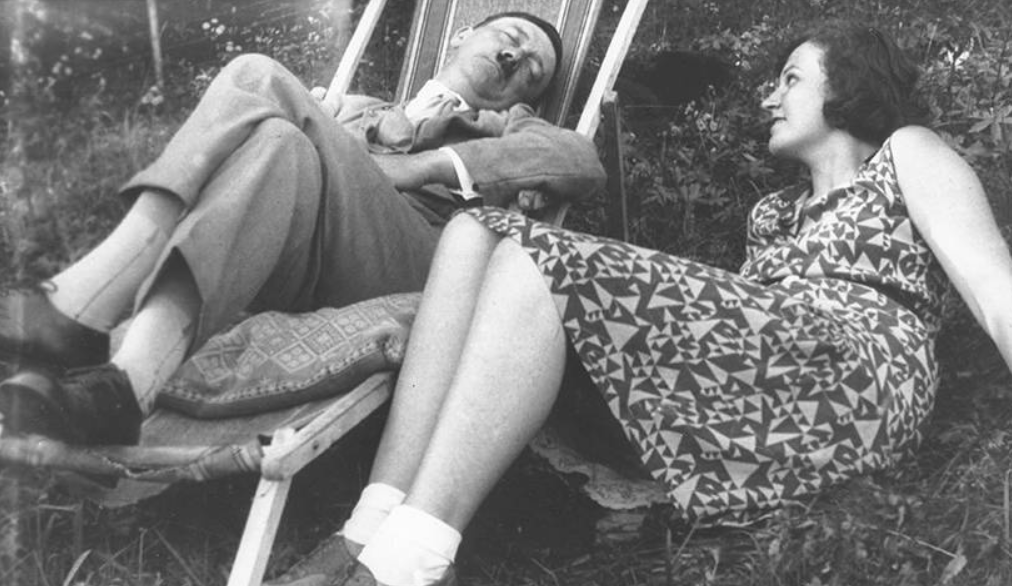
The left-wing Nazi leader, Otto Strasser, recorded and circulated Geli’s truly lurid account of this activity, emphasizing her disgust. Unfortunately, Hitler had also written a very compromising letter to her detailing his masochistic and coprophilic inclinations, and extreme steps were taken to retrieve it, with one of the parties being murdered on the Night of the Long Knives. Geli herself was found with an apparently self-administered bullet wound from Hitler’s handgun and apparently died a virgin (for those interested, a disturbing discussion of all this is provided in The Psychopathic God, especially pp.237-243).
Leaving Hitler aside, there is no question that key members of the Nazi Party were homosexual. Apart from Röhm (left), these included the Deputy Führer, Rudolf Hess, and it was noticed at the time that it was only Röhm and Hess who were allowed by Hitler to address him in a familiar ‘du’ fashion. Others cited by historians include Baldur von Schirach, the anti-Semitic and anti-Christian head of the Hitler Youth, who was later Reich Governor of Vienna and responsible for the deaths of thousands of Viennese Jews sent to the death camps; Hans Frank, the Nazi Minister of Justice; Walther Funk, the Minister of Economics; and 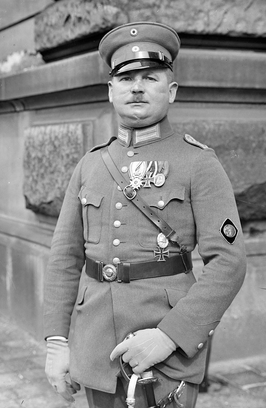 Hermann Goering, the President of the Reichstag and chief of the Luftwaffe, amongst many others.
Hermann Goering, the President of the Reichstag and chief of the Luftwaffe, amongst many others.
Hess was well known as an habitué of the famous LGBTIQ subculture of Berlin in the Weimar era, and was famous in the city’s gay bars for his dress-up attire as ‘Black Bertha’. Röhm (right), on the other hand, was the archetypal Nazi from central casting – a scar-faced ex-soldier and fanatical militarist. However, despite his later transformation (à la Goering) into a bloated, dissolute thug he was very cultured, and affected a flamboyantly masculinist style that reflected his military background and the intimate, male-only ‘life in the trenches’ during the war. After the war he had been Hitler’s mentor at the start of his rise to power, employing a destitute Hitler as an informer for the far-right paramilitary force, the Freikorps, in 1919, and may also have been his lover. Subsequently, Röhm remained a key confident and right-hand man, shaping the SA into a massive and ultraviolent paramilitary force designed to attack and intimidate rival political groups, and generally do Hitler’s dirty work.
The SA leadership and a great deal of its membership were committed to Röhm’s ideology of homosexual supremacism. A similar situation initially existed within Heinrich Himmler’s even more malevolent SS, where it was however inextricably combined with an ideology of racial purity, a grotesque idealization of ‘Aryan manhood’, and Himmler’s Lebensborn (‘fountain of life’) breeding program, designed to produce a ‘master-race’ of blond haired Aryans. A chicken farmer obsessed with breeding, Himmler eventually made it a capital offence for SS members to be homosexual, an extreme measure whose necessity is a measure of the scale of the homosexual presence in the SS.
Röhm was an articulate anti-bourgeois sexual radical, of the type that proliferated amongst the extreme decadence of Berlin in the post-war Weimar Republic. Berlin was famous for its Bohemian artists, sexual sadomasochism, transvestites and lesbian and male homosexual nightclubs, bars, and baths. Pornography, organized crime and drugs were rampant, as was child and 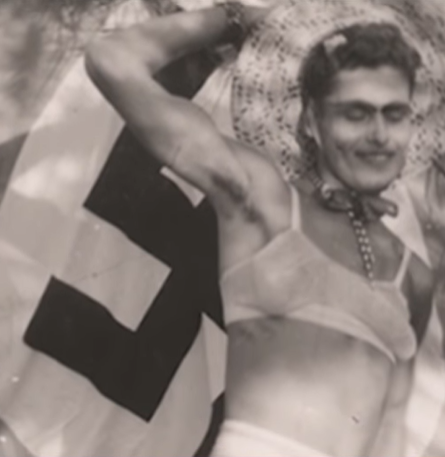 homosexual prostitution. In this milieu, according to Robert Elson in Prelude to War (1976), thousands of prostitutes walked Berlin’s city streets half nude, dressed as dominatrixes and school girls, while transvestites and rouged young men everywhere sold their services. As Havelock Ellis reported in The Psychology of Sex (1934), some 20,000 boy prostitutes serviced Germany’s flourishing gay population. And as the gay British novelist, Christopher Isherwood, rejoiced, “Berlin is for boys …The German Boy … the Blond”.
homosexual prostitution. In this milieu, according to Robert Elson in Prelude to War (1976), thousands of prostitutes walked Berlin’s city streets half nude, dressed as dominatrixes and school girls, while transvestites and rouged young men everywhere sold their services. As Havelock Ellis reported in The Psychology of Sex (1934), some 20,000 boy prostitutes serviced Germany’s flourishing gay population. And as the gay British novelist, Christopher Isherwood, rejoiced, “Berlin is for boys …The German Boy … the Blond”.
Flourishing in such a context, Röhm championed aggressive male homosexuality, talked openly about his fondness for gay bars and bath houses, boasted of his virility, and wrote pamphlets and articles calling for the repeal of laws against homosexuality. As one gay journalist reports, Röhm was a homosexual supremacist who “believed that gay people were superior to straights, and saw homosexuality as a key principle of his proposed Brave New Fascist Order.” In the words of the historian, Louis Snyder, Röhm
…projected a social order in which homosexuality would be regarded as a human behaviour pattern of high repute… He flaunted his homosexuality in public and insisted his cronies do the same. He believed straight people weren’t as adept at bullying and aggression as homosexuals, so homosexuality was given a high premium in the SA.
In this gay, ultra-masculinist, militarist society, effeminate passive homosexuals were conflated with women as inferior beings to be ridiculed and marginalized, as Millett recognized.
Although Röhm promoted these ideas within the SA and the Party with Hitler’s implicit consent, he finally became surplus to requirements when Hitler seized power and the army made it clear they wouldn’t tolerate the rival SA. Consequently, Röhm and his intimate circle and many other potential troublemakers were murdered on ‘the Night of the Long Knives’, June 30, 1934. Afterwards, in a typically cynical cover-up, Hitler justified the purge on the basis that Röhm was a homosexual and had to be liquidated as he was discrediting the Party. The Nazis then began a concerted campaign against male homosexuals. This focused on the Nazi Party and largely consumed men who were in the SA, the SS, and other parts of the party apparatus.
As this brief discussion illustrates, the question of the LGBTIQ community and the Nazis is one fraught with difficulty and controversy. It has been an achievement of the LGBTIQ movement to suppress knowledge of the role that male homosexuals played in the Nazi Party and the nature of the homosexual supremacism promoted by Nazi leaders like Röhm. One wonders therefore about the wisdom of Mark Dreyfus’s aggressive pursuit of the issue, which seems designed to place it at the top of the contemporary political agenda.
Madam: Archbishop Fisher (July-August 2024) does not resist the attacks on his church by the political, social or scientific atheists and those who insist on not being told what to do.
Aug 29 2024
6 mins
To claim Aborigines have the world's oldest continuous culture is to misunderstand the meaning of culture, which continuously changes over time and location. For a culture not to change over time would be a reproach and certainly not a cause for celebration, for it would indicate that there had been no capacity to adapt. Clearly this has not been the case
Aug 20 2024
23 mins
A friend and longtime supporter of Quadrant, Clive James sent us a poem in 2010, which we published in our December issue. Like the Taronga Park Aquarium he recalls in its 'mocked-up sandstone cave' it's not to be forgotten
Aug 16 2024
2 mins







